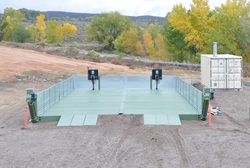
by Brianna Crandall — January 19, 2015—Facilities managers who are overseeing a construction/renovation project, landscaping project, or other project utilizing heavy equipment and are concerned about the amount of wastewater and dirt and debris that is washed away when cleaning the equipment may be interested in an innovative heavy-duty washing system from Hydro Engineering.
The sustainable Hydropad wash rack system can be configured to capture wastewater produced from washing vehicles and equipment without compromising a job site with contaminants that are brought in from a job and potentially let out into the environment.
Hydropad systems are platforms onto which vehicles, equipment, hardware, or components are placed in order to be washed. They are engineered to capture water and channel effluent to the gutter systems of the Hydropad. Captured effluent can then be diverted to the company’s Hydrokleen water filtration systems and sent back out to its Hydroblaster washing system for 100% water efficiency.
Hydropad portable wash racks are also designed for maneuverability as well as safe set-up and tear-down. Weight load capacities can reach anywhere from two tons of light equipment (passenger vehicles, personal vehicles, etc.) up to 70 tons (per Hydropad) of heavy-duty mining equipment. Hydropad’s dimensions are a compact 8′ x 20′ section. Multiple Hydropads can be linked together to accommodate any range of heavy equipment and landscaping maintenance needs.
To accommodate wash jobs of varying scope and magnitude, Hydropads can be configured to include optional sliding side wall panels on one or all sides that assist in capturing the overspray of a typical wash. The panels range in size from up to 6′ high outdoors to 12′ high indoors to fit large and tall heavy duty equipment to be thoroughly cleaned in order to cut back on maintenance costs.
When washing vehicles and equipment, the company offers three methods to collect, contain and dispose of commonplace contaminants such as soaps, oil, dirt, and debris captured by Hydropad units:
- Each Hydropad includes a gutter. In applications where solids are at a minimum, the side gutter can be cleaned manually, with a shovel.
- Hydropads can also be equipped with a remote drive-in, clean-out tray. Drive-in trays collect more debris without the need for constant removal. When dirt removal is required, it is done with a backhoe or skid steer loader.
- Finally, Hydro Engineering has developed a patented drag conveyor system that automates solids removal and deposits waste into any type of receptacle that is desired.
Hydro Engineering will be showcasing its methods to make businesses more eco-friendly at the World of Concrete Show in Las Vegas, Nevada, and the GCSAA Expo in San Antonio, Texas, during the month of February.





